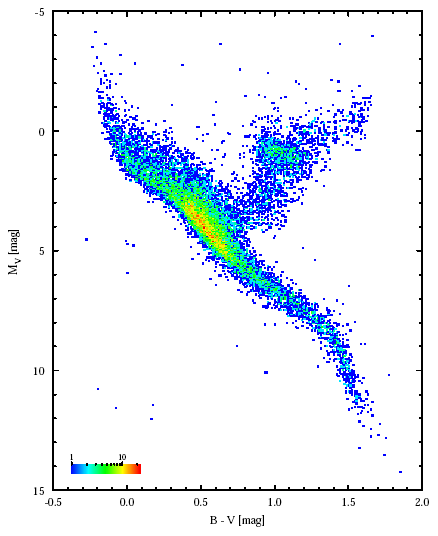|
|
 The Hertzsprung-Russell diagram of nearby stars, as measured by Hipparcos (click on image for a larger version). This image contains all the single (non-binary) stars whose distances were measured to better than 10%. Because Hipparcos had only a small telescope, the lower main sequence is under-counted, and there are almost no white dwarfs. Note that the vast majority of the stars lie on the main sequence. From the Hipparcos website.
The Hertzsprung-Russell diagram of nearby stars, as measured by Hipparcos (click on image for a larger version). This image contains all the single (non-binary) stars whose distances were measured to better than 10%. Because Hipparcos had only a small telescope, the lower main sequence is under-counted, and there are almost no white dwarfs. Note that the vast majority of the stars lie on the main sequence. From the Hipparcos website.
|
Summary of Lecture 3 – Understanding Stars
-
The Hertzsprung-Russell diagram is a plot of the luminosity of stars against their surface temperature (on a logarithmic scale).
- Absolute magnitude (linear scale, increasing downward) can be plotted instead of luminosity.
- Spectral class (OBAFGKM) or colour (from blue to red, on a numerical scale called the colour index) can be plotted instead of temperature.
- note that on the HR diagram temperature is plotted increasing from right to left (i.e. backwards)!
- If you are looking at a stellar cluster, you can use apparent magnitude on the y axis, because all the stars are at roughly the same distance from us. All the magnitudes will be increased by 5 log(d/10) compared to their absolute values, but the shape of the diagram will not change.
- Nearby stars plotted on the HR diagram fall into well-defined regions:
- main sequence from top left (hot and bright) to bottom right (cool and faint);
- red giants at top right (bright but cool);
- the red clump at about magnitude 0 in the middle of the red giant branch (this is the equivalent of the horizontal branch in globular clusters, but it does not stretch out to the blue if the stars have high heavy element content);
- white dwarfs at bottom left (hot but faint).
- As stars are approximately blackbodies, we can estimate their sizes by combining brightness and temperature:
- Main sequence stars increase in size from bottom right to top left.
- Red giants are very large (orbit of Mercury).
- White dwarfs are extremely small (similar to the Earth).
- Using binary stars we can also plot luminosity against mass:
- for main sequence stars, increasing luminosity means increasing mass;
- luminosity increases much faster than mass (factor 10 in mass means at least factor 1000 in luminosity)
- therefore, massive stars must use up their fuel much faster than less massive stars, and will have shorter life-spans on the main sequence.
- The size of a star is determined by a balance of forces:
- gravity pulling the material inward;
- pressure increasing with depth, therefore pushing material outward;
- to maintain pressure, star is hotter at depth → central energy source.
- The central energy source is nuclear fusion:
- only energy source capable of maintaining luminosity for required lifetime (known from age of solar system);
- produces neutrinos (observed from Sun);
- consistent with Sun's interior structure as deduced from helioseismology;
- produces heavy elements as observed in stars.
- Theories of stellar structure and evolution can be tested by studying stellar clusters:
- open clusters contain a few hundred stars, the brightest usually being hot main sequence stars;
- globular clusters contain a few hundred thousand stars, low in heavy elements, the brightest being red giants (no blue main-sequence stars).
From the relative lifespans of bright and faint main sequence stars, we deduce that globular clusters are very old and open clusters typically rather young. From the fact that red giants increase in number as the upper main sequence disappears, we suspect that red giants are an evolution stage later than the main sequence.
Web links
Go back to main page
Go on to Summary for Lecture 4
|
Hicks Building, Hounsfield Road, Sheffield S3 7RH, UK
|